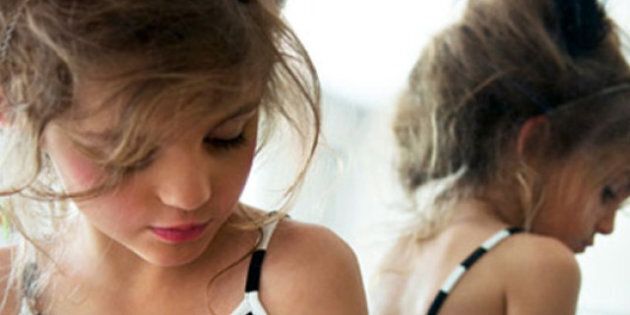
Three things. One: I had photos taken of myself at 11 wearing a corset and I liked it.
Two: When I was 12, I read Lolita.
Three: I have a problem with the Jours Après Lunes (days after moons) collection campaign that shows prepubescent girls in lingerie, with big hair and makeup, sitting in poses that suggest, oh let's just say it -- a recent sexual encounter or a possibility of one.
The company has defended itself saying that they are a family brand and that there are no vulgar connotations, the children are professional models, "not Lolitas who have stolen women's clothing."
Additionally, it was said that the panties are opaque and there are no bras in the collection (presumably, the featured striped bikini top or a satin-and-black-thing-that-is-not-a-bra are socks). Other defenders of the company have blamed the outrage on North American prudishness. Which is also what seemed to be at fault recently when people got upset over Thylane Lena-Rose Blondeau, a 10-year-old who posed for the French Vogue looking like a child version of Brigitte Bardot in most of the photos.
I don't have a daughter, but I used to be a little girl and I remember how confusing sexuality was, for example, my lack of understanding between the power of clothing as signifier (of sex) and the people (men) who responded. Because clothing is not just clothing -- we, animals who dress -- use it to tell the world certain things about ourselves. A guy in a colourful Etro shirt is a peacock with his tail in full spread. A grown woman in a Catholic school girl outfit is suggesting perversity (through the uniform's connotation combined with the woman's age). A 12-year-old girl with big teased-up hair in a clothing ad, wearing a satin not-a-bra and panties is suggesting that she's playing a woman, someone ready to have sex.
Jours Après Lunes defended itself by saying that the clothing is not "stolen women's clothing" and further on that it was designed, specifically to suggest the idea of dress up. What a brilliant idea -- the girls don't have to raid their mother's closets because now they have their own suppliers of almost same kind of clothing but in the right sizes. Except that when little girls dress up to be like mom or a lady on TV they do it precisely because it's part of a play and after the playing is done they get to put away mom's lacy bra stuffed with Kleenex and put on their own dresses. If they end up wearing women's clothes every day what exactly are they saying?
When you make the grown-up-like clothing available and acceptable, the kids will wear it -- especially if moms (who else?) buy it. Why not? Mommy has a frilly tank top that shows off her chest, so why shouldn't her daughter have one, especially one produced by a pretty French company named days after moons (or should it be "the morning after"?). And the little girl will put on a string bikini not understanding at all what the string is meant to suggest, not understanding that it's a signifier. When I wear a string bikini I am more than aware that it signals the possibility of the string being pulled, the idea that I can just loosen my clothes like that. If I had a daughter I would not like anyone to think that when looking at her.
But as I said, I don't have a daughter but I have pictures of myself as a kid wearing a grown-up corset. My friend A. stole it from her grandmother's closet; it was a beautiful thing supported by metal stays and heavy silk exquisitely stitched together. It was meant for a much smaller grown-up person, but, as we discovered, it fit an 11-year-old. Our idea of sex was that you kissed a man who should probably look a little bit like Michael Jackson, whom we both adored.
We knew about intercourse and we understood that the corset was sexy but how the two were related was a mystery. We took photos of each other wearing the corset, even striking a couple of what we thought were sexy poses. We got the photos developed later and I haven't looked at them for many years, slightly worried that I committed a minor crime, had definitely done something troubling. I also knew that I meant something but I didn't know what I meant. This was not in North America, the land of prudishness, but it still seemed like a bad idea.
And then I read Vladimir Nabokov's Lolita when I was Lolita's age, not understanding any of it but I heard that it was about a relationship between a grown man and a very young girl and that there was sex in the book. Plus the book was kind of a scandal. I read the words and sentences and I saw page numbers. I understood what they were but the meaning escaped me. So I read the annotations explaining the symbolism, imagery and allegory. Still clueless. I thought I even found the sex parts but I wasn't sure. All I knew was that there was something huge eluding me, some kind of a thrilling, dangerous thing that I couldn't see because despite my eagerness to grow up I was too young, too stupid, too dependent on grown ups to explain things to me and, hopefully, lead me in the right direction.